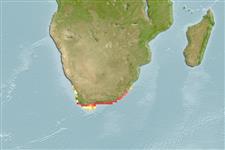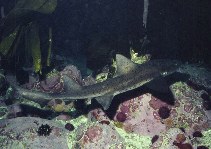Triakis megalopterus (Smith, 1839)
Sharptooth houndshark
Ajouter votre observation dans Fish Watcher
| Native range | All suitable habitat | Point map | Year 2050 |

|
| This map was computer-generated and has not yet been reviewed. |
| Triakis megalopterus AquaMaps Data sources: GBIF OBIS |
Envoyez vos Photos et vidéos
Pictures | Images GoogleTriakis megalopterus
Picture by Zsilavecz, G.
Pictures | Images GoogleTriakis megalopterus
Picture by Zsilavecz, G.
South Africa country information
Common names:
Gespikkelde sloothaai, Spotted gully shark, Spotted gullyshark
Occurrence: native
Salinity: marine
Abundance: common (usually seen) | Ref: van der Elst, R.P. and F. Adkin (eds.), 1991
Importance: minor commercial | Ref: Compagno, L.J.V., 1984
Aquaculture: | Ref:
Regulations: no regulations | Ref: van der Elst, R., 1993
Uses: gamefish: yes;
Comments: Ranges from the west coast to Coffee Bay, Transkei; rarely off Natal. Stock sound; commonly caught by rock and surf tournament anglers (Ref. 4332). There is a fairly large commercial fishery in Gans Bay (Ref. 244). Also Ref. 5485, 12484.
National Checklist:
Country Information: https://www.cia.gov/library/publications/resources/the-world-factbook/geos/sf.html
National Fisheries Authority:
Occurrences: Occurrences Point map
Main Ref: Compagno, L.J.V., D.A. Ebert and M.J. Smale, 1989
National Database:
Occurrence: native
Salinity: marine
Abundance: common (usually seen) | Ref: van der Elst, R.P. and F. Adkin (eds.), 1991
Importance: minor commercial | Ref: Compagno, L.J.V., 1984
Aquaculture: | Ref:
Regulations: no regulations | Ref: van der Elst, R., 1993
Uses: gamefish: yes;
Comments: Ranges from the west coast to Coffee Bay, Transkei; rarely off Natal. Stock sound; commonly caught by rock and surf tournament anglers (Ref. 4332). There is a fairly large commercial fishery in Gans Bay (Ref. 244). Also Ref. 5485, 12484.
National Checklist:
Country Information: https://www.cia.gov/library/publications/resources/the-world-factbook/geos/sf.html
National Fisheries Authority:
Occurrences: Occurrences Point map
Main Ref: Compagno, L.J.V., D.A. Ebert and M.J. Smale, 1989
National Database:
Common names from other countries
Classification / Names Noms communs | Synonymes | Catalog of Fishes(Genre, Espèce) | ITIS | CoL | WoRMS | Cloffa
Élasmobranches (requins et raies) (sharks and rays) > Carcharhiniformes (Ground sharks) > Triakidae (Houndsharks) > Triakinae
Etymology: Triakis: tri-, from tres (L.), three; akis (Gr.), point, referring to each tooth consisting of one large central cusp flanked on by both sides by a small cusplet (See ETYFish); megalopterus: mega-, from megas (Gr.), large; pterus (Gr.), fin, referring to its broad, large fins (See ETYFish).
More on author: Smith.
Etymology: Triakis: tri-, from tres (L.), three; akis (Gr.), point, referring to each tooth consisting of one large central cusp flanked on by both sides by a small cusplet (See ETYFish); megalopterus: mega-, from megas (Gr.), large; pterus (Gr.), fin, referring to its broad, large fins (See ETYFish).
More on author: Smith.
Environment: milieu / climate zone / depth range / distribution range Écologie
marin démersal; profondeur 1 - 50 m (Ref. 5578). Subtropical; 30°S - 36°S
Distribution Pays | Zones FAO | Écosystèmes | Occurrences | Point map | Introductions | Faunafri
Southeast Atlantic: Namibia to Coffee Bay, South Africa.
Length at first maturity / Taille / Poids / Âge
Maturity: Lm 145.0, range 140 - 150 cm
Max length : 142 cm TL mâle / non sexé; (Ref. 244); 174.0 cm TL (female); poids max. publié: 20.0 kg (Ref. 5485)
Max length : 142 cm TL mâle / non sexé; (Ref. 244); 174.0 cm TL (female); poids max. publié: 20.0 kg (Ref. 5485)
Description synthétique Clés d'identification | Morphologie | Morphométrie
Épines dorsales (Total) : 0; Épines anales: 0. Blunt snout and a large mouth with small pointed teeth; caudal peduncle short and heavy (Ref. 5578). Grey with numerous black spots which may be sparse or absent in some specimens; new born pups with fewer black spots compared to adults (Ref. 5485); white below (Ref. 5578).
Occurs off sandy beaches, rocky shores and in shallow bays (Ref. 5578). Feeds on crabs, lobsters, bony fish and small sharks (Ref. 5578). Ovoviviparous (Ref. 50449). Forms schools in summer (Ref. 244). Hardy and keeps well in captivity (Ref. 244). Commonly caught by rock and surf sports anglers but not eaten much (Ref. 244). Meat is dried into shark 'biltong' or jerky which commands a relatively high price (Ref. 244). Attains 160 cm, TL (Ref. 36731).
Life cycle and mating behavior Maturité | Reproduction | Frai | Œufs | Fécondité | Larves
Ovoviviparous, embryos feed solely on yolk (Ref. 50449), with 6 to 12 young in a litter (Ref. 244). 30-32 cm at birth (Ref. 244).
Référence principale
Upload your references | Références | Coordinateur : Compagno, Leonard J.V. | Collaborateurs
Compagno, L.J.V., 1984. FAO Species Catalogue. Vol. 4. Sharks of the world. An annotated and illustrated catalogue of shark species known to date. Part 2 - Carcharhiniformes. FAO Fish. Synop. 125(4/2):251-655. Rome: FAO. (Ref. 244)
Statut dans la liste rouge de l'IUCN (Ref. 130435: Version 2024-2)
Préoccupation mineure (LC) ; Date assessed: 01 August 2019
Menace pour l'homme
Harmless
Utilisations par l'homme
Pêcheries: intérêt commercial mineur; pêche sportive: oui; Aquarium: Aquariums publics
FAO(pêcheries: production; publication : search) | FishSource | Sea Around Us
Plus d'informations
Trophic ecology
Éléments du régime alimentaire
Composition du régime alimentaire
Consommation alimentaire
Food rations
Prédateurs
Éléments du régime alimentaire
Composition du régime alimentaire
Consommation alimentaire
Food rations
Prédateurs
Population dynamics
Paramètres de croissance
Max. ages / sizes
Length-weight rel.
Length-length rel.
Fréquences de longueurs
Mass conversion
Recrutement
Abondance
Paramètres de croissance
Max. ages / sizes
Length-weight rel.
Length-length rel.
Fréquences de longueurs
Mass conversion
Recrutement
Abondance
Life cycle
Reproduction
Maturité
Fécondité
Frai
Spawning aggregations
Œufs
Développement de l'œuf
Larves
Dynamique des populations larvaires
Reproduction
Maturité
Fécondité
Frai
Spawning aggregations
Œufs
Développement de l'œuf
Larves
Dynamique des populations larvaires
Anatomy
Surface branchiale
Brain
Otolith
Surface branchiale
Brain
Otolith
Physiology
Body composition
Nutrients
Consommation d'oxygène
Type de nage
Vitesse de nage
Visual pigments
Fish sound
Diseases & Parasites
Toxicity (LC50s)
Body composition
Nutrients
Consommation d'oxygène
Type de nage
Vitesse de nage
Visual pigments
Fish sound
Diseases & Parasites
Toxicity (LC50s)
Genetics
Génétique
Heterozygosity
Héritabilité
Génétique
Heterozygosity
Héritabilité
Human related
Aquaculture systems
Profils d'aquaculture
Souches
Ciguatera cases
Stamps, coins, misc.
Aquaculture systems
Profils d'aquaculture
Souches
Ciguatera cases
Stamps, coins, misc.
Outils
Bio-Quiz | E-book | Guide de terrain | Générateur de fréquences de longueur | Outil de dynamique de population | Carte par point | Classification Tree
| Catch-MSY |
Articles particuliers
Télécharger en XML
Sources Internet
Aquatic Commons | BHL | Cloffa | Websites from users | FishWatcher | CISTI | Catalog of Fishes(Genre, Espèce) | DiscoverLife | ECOTOX | Faunafri | Fishtrace | GenBank(génôme, nucléotide) | GloBI | GOBASE | | Google Books | Google Scholar | Google | IGFA World Record | MitoFish | Otolith Atlas of Taiwan Fishes | Aquariums publics | PubMed | Reef Life Survey | Scirus | SeaLifeBase | Arbre de Vie | Wikipedia(aller à, chercher) | World Records Freshwater Fishing | Zoological Record
Estimates based on models
Preferred temperature (Ref. 115969): 15.8 - 22.4, mean 19.3 (based on 26 cells).
Phylogenetic diversity index (Ref. 82804): PD50 = 0.5312 [Uniqueness, from 0.5 = low to 2.0 = high].
Bayesian length-weight: a=0.00245 (0.00114 - 0.00526), b=3.13 (2.95 - 3.31), in cm Total Length, based on LWR estimates for this (Sub)family-body shape (Ref. 93245).
Niveau trophique (Ref. 69278): 4.0 ±0.5 se; based on diet studies.
Résilience (Ref. 120179): Très faible, temps minimum de doublement de population supérieur à 14 ans (Fec=6).
Fishing Vulnerability (Ref. 59153): Very high vulnerability (90 of 100).




